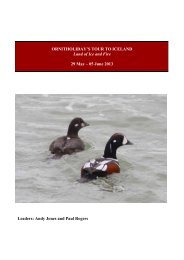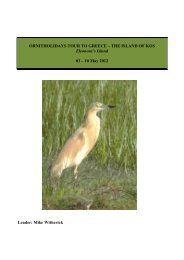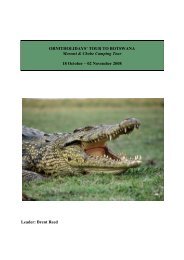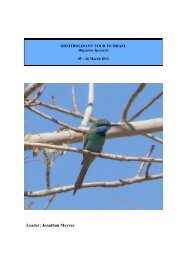Download 2014 Brochure (.pdf) - Ornitholidays
Download 2014 Brochure (.pdf) - Ornitholidays
Download 2014 Brochure (.pdf) - Ornitholidays
Create successful ePaper yourself
Turn your PDF publications into a flip-book with our unique Google optimized e-Paper software.
E C U A D O R<br />
Ecuador<br />
Tumbesian & Andean Specialties<br />
Saturday 04 October – Sunday 19 October <strong>2014</strong><br />
Leaders: Trevor Ellery and local guides<br />
<strong>2014</strong> Cost £4,499 single room supplement £150<br />
Guayaquil<br />
Cuenca<br />
ECUADOR<br />
Buenaventura<br />
ith a diverse combination of habitats and a mouth-watering list of specialties it is no<br />
Vilcabamba<br />
Jorupe<br />
W surprise that the southern Ecuador circuit has become very popular in recent years. This<br />
Copalinga<br />
tour will take in everything from lowland marshes to high elevation paramos while offering the chance to<br />
Tapichalaca Reserve<br />
see some of the rarest birds in the world. Species we will target will include the recently re-discovered<br />
Pale-headed Brush-Finch, the incredibly rare El Oro Parakeet and the iconic Jocotoco Antpitta. We will also<br />
concentrate on the tumbesian endemics, those species only found in the dry tumbes forests that cover southern Ecuador and northern Peru.<br />
The tour begins in the humid marshes that surround the city of Guayaquil, where we look for the ungainly Horned Screamer, before quickly moving<br />
on to the cloud forests of the Buenaventura Reserve. The verdant hillsides here represent one of the most southerly outposts of the great Choco<br />
bioregion that covers much of western Colombia and Ecuador. They offer a unique opportunity to see Choco specialties such Long-wattled<br />
Umbrellabird and Club-winged Manakin, alongside Tumbesian specialities such as Rufous-headed Chachalaca. We then strike south into the dry<br />
forests that so characterise the tumbes region where we spend several days. Following this we head up into the cool temperate highlands of Cerro<br />
Toledo and the Tapichalca reserve where we can search out a small suite of rare and exciting species including Jocotoco Antpitta, Neblina Metaltail<br />
and Masked Mountain-Tanager. The last few days see us drop down to the edge of the Amazon for some foothill birding around the very pleasant<br />
Copalinga Lodge, before once again ascending to the wild and windswept paramos of El Cajas National Park. We also find time to squeeze in a visit<br />
to the small Yungillas reserve situated in an arid inter-Andean valley and finish the tour with a final visit to a dry scrub reserve right on the edge of<br />
Guayaquil where we can hope to enjoy our final few hours, once again enjoying some of the Tumbesian specialties.<br />
ITINERARY<br />
Day 1<br />
We depart from London and fly to Guayaquil<br />
where we arrive later the same day. On arrival we<br />
meet up with Trevor and then transfer to our hotel<br />
where we have dinner and stay overnight.<br />
Days 2 & 3<br />
We spend the morning birding at the Manglares<br />
Churute Reserve on the outskirts of Guayaquil.<br />
We should enjoy good views of Horned<br />
Screamer and a selection of wetland birds, while<br />
the nearby scrub may hold Pacific Royal<br />
Flycatcher, Jet Antbird and Orange-crowned<br />
White-tailed Jay<br />
Euphonia. We will also look out for our first<br />
Tumbesian specialities such as Pacific Pygmy<br />
Owl and Pacific Hornero. We will leave the site<br />
mid-morning and undertake a fairly long drive<br />
south to the Buenaventura Reserve. In the early<br />
evening we arrive our lodge at Buenaventura<br />
where we spend two nights. We will spend one<br />
full day exploring the trails at Buenaventura. Our<br />
main target will be the critically endangered El<br />
Oro Parakeet but we will also look for Longwattled<br />
Umbrellabird, Esmeraldas Antbird and<br />
Club-winged Manakin. We will also take some<br />
time out to enjoy the spectacular hummingbird<br />
feeders which can hold 50 or more individual<br />
hummingbirds at any one time, including such<br />
species as Violet-bellied Hummingbird, Green<br />
Thorntail and Green-crowned Woodnymph.<br />
Days 4 to 6<br />
We spend a final morning at Buenaventura<br />
before making a fairly long drive south to Jorupe<br />
where we stay for three nights at Jorupe Lodge.<br />
We can break the journey up by stopping in the<br />
El Empalme area where we hope to find such<br />
species as Baird’s Flycatcher, Tumbes<br />
Hummingbird and White-headed Brush-Finch.<br />
The next day we bird the trails and feeding<br />
stations around Jorupe Lodge. Targets include<br />
Henna-hooded and Rufous-necked Foliagegleaners,<br />
Blackish-headed Spinetail,<br />
Pale-browed Tinamou (visiting the feeders!),<br />
Watkin’s Antpitta, Slaty Becard and White-edged<br />
Oriole. On our last full day we visit the higher<br />
elevation Sozoranaga and Utana areas where we<br />
can look for Chapman’s Antshrike, Black-cowled<br />
Saltator, Puira Hemispingus, Bay-crowned<br />
Brush-Finch, Jelski’s Chat-Tyrant and Blackcrested<br />
Tit-Tyrant. We also hope to enjoy<br />
Rainbow Starfrontlet and Purple-throated<br />
Sunangel at the hummingbird feeders.<br />
Day 7<br />
We spend a final morning in the Utana Reserve<br />
looking for Grey-headed Antbird and any<br />
species we did not see on the previous day. We<br />
then drive to Vilcabamba where we overnight.<br />
On route we can stop in the Catayamo Valley<br />
where we will look for such specialties as Drab and<br />
Parrot-billed Seedeaters and Tumbes Sparrow.<br />
Days 8 & 9<br />
We spend the morning birding at Cerro Toledo<br />
near Vilcabamba where we hope to see such<br />
high Andean specialties as the endemic Neblina<br />
Metaltail and the scarce Masked Mountain-<br />
Tanager. We will also look out for Grey-breasted<br />
Mountain-Toucan, Red-hooded Tanager and<br />
Mouse-coloured Thistletail In the afternoon we<br />
drive to the Tapichalaca Reserve where we stay<br />
for two nights. The next day we visit the famous<br />
Jocotoco Antpitta worm feeding station where<br />
we hope to enjoy close up views of this<br />
spectacular species. We spend the rest of the<br />
40<br />
For a previous tour report or further information please call: 01794 519445








